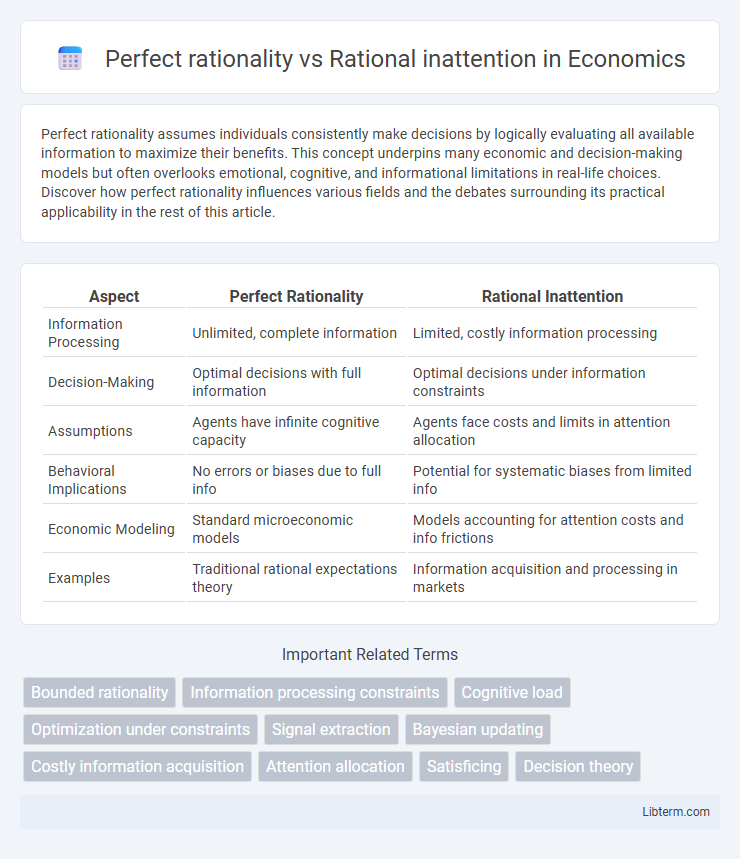Perfect rationality assumes individuals consistently make decisions by logically evaluating all available information to maximize their benefits. This concept underpins many economic and decision-making models but often overlooks emotional, cognitive, and informational limitations in real-life choices. Discover how perfect rationality influences various fields and the debates surrounding its practical applicability in the rest of this article.
Table of Comparison
| Aspect | Perfect Rationality | Rational Inattention |
|---|---|---|
| Information Processing | Unlimited, complete information | Limited, costly information processing |
| Decision-Making | Optimal decisions with full information | Optimal decisions under information constraints |
| Assumptions | Agents have infinite cognitive capacity | Agents face costs and limits in attention allocation |
| Behavioral Implications | No errors or biases due to full info | Potential for systematic biases from limited info |
| Economic Modeling | Standard microeconomic models | Models accounting for attention costs and info frictions |
| Examples | Traditional rational expectations theory | Information acquisition and processing in markets |
Understanding Perfect Rationality
Perfect rationality assumes that decision-makers have unlimited cognitive resources and complete information to make optimal choices, maximizing utility in every situation. This model underpins classical economic theories, presuming consistent preferences and flawless calculation abilities. Understanding perfect rationality highlights its idealized nature, which often contrasts with real-world decision-making where information processing constraints and attention limits come into play.
Defining Rational Inattention
Rational inattention models decision-making under cognitive constraints, where individuals allocate limited attention optimally to process relevant information. Unlike perfect rationality, which assumes unlimited cognitive resources for fully informed decisions, rational inattention captures how information costs impact behavior and choices. This concept integrates principles from information theory and economics to explain observed deviations from perfectly rational actions.
Key Differences: Rationality vs Inattention
Perfect rationality assumes agents have unlimited cognitive resources and access to complete information, enabling them to make fully optimal decisions. Rational inattention recognizes cognitive limitations and the costs associated with acquiring and processing information, leading agents to selectively attend to certain data while ignoring others. The key difference lies in how information is handled: perfect rationality implies exhaustive knowledge and processing, whereas rational inattention accepts bounded rationality with strategically limited attention.
Historical Origins and Theoretical Background
Perfect rationality, rooted in classical economics and expected utility theory, assumes agents possess unlimited cognitive resources to process all available information and optimize decisions accordingly. Rational inattention, introduced by Christopher Sims in the early 2000s, challenges this notion by incorporating cognitive limitations and information-processing costs, thereby modeling decision-making under bounded rationality. Theoretical frameworks of rational inattention draw from information theory and economic modeling, bridging gaps left by classical theories by accounting for imperfect information acquisition and selective attention.
Cognitive Limitations and Information Processing
Perfect rationality assumes decision-makers possess unlimited cognitive capacity to process all available information and optimize outcomes flawlessly. In contrast, rational inattention accounts for cognitive limitations, recognizing that individuals selectively process information due to finite attention and mental resources. This framework models decision-making under information-processing constraints, emphasizing trade-offs between acquiring information and the cost of cognitive effort.
Economic Models: Assumptions and Realism
Economic models of perfect rationality assume agents have unlimited cognitive resources and access to all relevant information, enabling optimal decision-making. Rational inattention models incorporate realistic cognitive constraints, recognizing that agents selectively process information due to limited attention and costly information acquisition. This shift enhances the realism of economic analysis by better capturing observed behaviors and information-processing limitations in real-world markets.
Impacts on Decision-Making and Behavior
Perfect rationality assumes individuals process all available information flawlessly to make optimal decisions, leading to consistent, utility-maximizing behavior. Rational inattention acknowledges cognitive limitations, causing decision-makers to selectively ignore information, which results in suboptimal choices influenced by information-processing costs. This distinction impacts behavior by explaining why real-world decisions often deviate from ideal models due to attention constraints and information overload.
Applications in Real-World Economic Scenarios
Perfect rationality assumes agents process all available information without cost, enabling optimal decision-making in economic models such as market equilibrium and auction theory. Rational inattention recognizes cognitive and informational costs, modeling how agents selectively acquire and process information, which better explains observed behaviors in financial markets, consumer choice, and labor economics. Incorporating rational inattention improves predictions of responses to policy changes, asset pricing anomalies, and consumption-savings decisions under uncertainty.
Critiques and Limitations of Each Approach
Perfect rationality assumes agents have unlimited cognitive resources and access to all relevant information, leading to unrealistic predictions and overlooking human cognitive constraints. Rational inattention incorporates information processing costs, but its assumptions about how agents prioritize information can be overly simplistic and may not capture complex decision environments. Both approaches struggle with empirical validation due to difficulties in measuring cognitive costs and the variability of real-world decision-making behaviors.
Future Directions in Rationality Research
Future directions in rationality research emphasize integrating perfect rationality models with rational inattention frameworks to better capture decision-making under information processing constraints. Advances explore optimizing attention allocation while considering cognitive resource limitations, linking economic theory with neuroscience insights. Developing hybrid models aims to enhance predictive accuracy in real-world scenarios, bridging normative and descriptive approaches.
Perfect rationality Infographic

 libterm.com
libterm.com